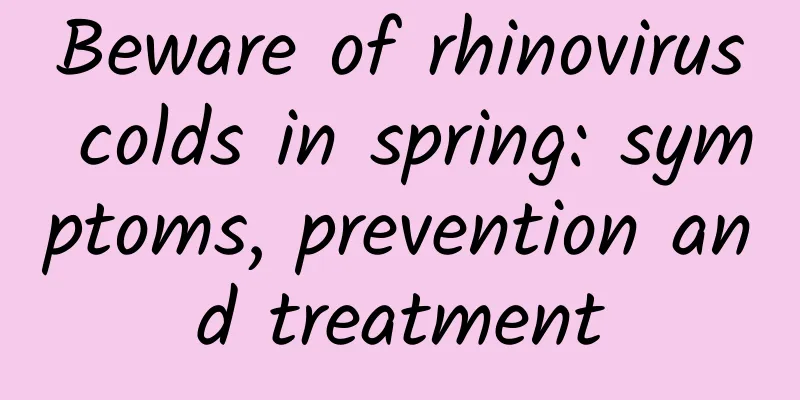Beware of rhinovirus colds in spring: symptoms, prevention and treatment

|
Spring is the peak season for rhinovirus colds. Rhinovirus is the most common pathogen causing the common cold, accounting for about 30%-50% of cold cases. This virus is most active in an environment of 15℃ to 20℃, and the temperature and humidity conditions in spring provide an ideal breeding environment for it. 1. Characteristics and hazards of rhinovirus colds Rhinovirus is a single-stranded RNA virus belonging to the Picornaviridae family. It is highly contagious and is mainly transmitted through droplets and contact. After the virus enters the human body, it mainly infects the upper respiratory tract and replicates in the epithelial cells of the nasopharynx. Typical symptoms appear within 1-2 days after infection: nasal congestion, runny nose, sneezing, sore throat, and possibly a slight fever. Compared with influenza, rhinovirus colds have relatively mild symptoms, but the course of illness is longer, usually lasting 7-10 days. Rhinovirus colds may cause a series of complications, including sinusitis, otitis media, aggravated asthma, etc. For children and the elderly with weak immunity, they may also develop lower respiratory tract infections. 2. Reasons for the high incidence of rhinovirus colds in spring The temperature fluctuates greatly in spring, and the human body's resistance is relatively weak, providing an opportunity for virus invasion. The temperature difference between indoor and outdoor causes the human body's regulatory function to be disrupted, and the defense ability of the respiratory mucosa is reduced. In spring, people spend more time outdoors, which increases the chances of virus transmission. Group activities such as school reopening and work resumption also create conditions for virus transmission. The ability of rhinovirus to spread increases significantly in the spring. Studies have shown that rhinovirus survives longest and is most contagious in an environment with a temperature of 20°C and a relative humidity of 50%. 3. Scientifically prevent rhinovirus colds Personal protection measures: Wash your hands frequently, using soap or alcohol-based hand sanitizer Avoid touching your eyes, nose, and mouth with your hands Cover your cough or sneeze with a tissue Maintain social distance and avoid close contact with people with colds Key points for environmental prevention and control: Keep the room ventilated at least twice a day for 30 minutes each time Regularly disinfect high-touch surfaces such as door handles and tabletops Use an air purifier to keep the indoor air fresh Control indoor humidity between 40%-60% Ways to enhance immunity: Get enough sleep, 7-8 hours a day Eat a balanced diet with plenty of foods rich in vitamin C Get at least 150 minutes of moderate-intensity exercise per week Maintain a good mental state and avoid excessive stress IV. Treatment and care of rhinovirus colds There is currently no specific antiviral drug, and treatment is mainly symptomatic: Use saline solution to rinse your nasal cavity to relieve nasal congestion Take antipyretics to relieve fever and headache Using lozenges or sprays to relieve throat irritation Get enough rest and drink plenty of water Seek medical attention immediately if you experience any of the following: High fever lasts for more than 3 days Difficulty breathing or chest pain Symptoms persist for more than 10 days without improvement Complications such as earache and facial pain Preventing rhinovirus colds requires the joint efforts of individuals, families and society. Through scientific preventive measures and a healthy lifestyle, we can effectively reduce the risk of infection and enjoy the beautiful spring time. If cold symptoms occur, take correct care measures in time and seek professional medical help when necessary. Let us work together to prevent and control respiratory diseases in spring and protect our health. |
<<: Attention! Don’t use this internet celebrity “panacea” recklessly!
>>: Legionella, a hidden health threat in our lives
Recommend
From hyperthyroidism to hypothyroidism, strategies for coping with thyroid disease during pregnancy
Author: Yang Zhaojun, Chief Physician of China-Ja...
Why do plagues always come back? When can infectious diseases be eradicated?
Follow "Body Code Decoding Bureau" (pub...
What is the most effective way to treat oral ulcers in pregnant women?
Oral ulcers are a common disease caused by inflam...
What to do if you have bleeding after induced abortion
We all know that induced labor, like giving birth...
How long does it take to get pregnant after taking intravenous drips during menstruation?
Because of inflammation, women may need intraveno...
What are the causes of blockage on one side of the fallopian tube?
The fallopian tube is a very important organ for ...
Do I need to wash after taking potassium permanganate sitz bath?
Potassium permanganate, also known as PP powder, ...
Erotic dream and uterine contraction during menstruation
Some women may have erotic dreams on the Internet...
Why does it hurt down there after having sex?
Sexual life is supposed to be a pleasant thing, b...
What foods can help teenage girls develop breasts?
Everyone knows that girls' breasts develop qu...
China's 400 million chronic disease population, in addition to being related to tobacco and alcohol, eating habits such as rice and steamed buns are also important causes
Introduction There are 400 million people diagnos...
What causes progesterone breakdown?
Corpus luteum rupture is an uncommon symptom that...
How to eat quail eggs? Homemade spiced quail eggs, simple and easy to learn, the first choice for breakfast!
In addition to some regular dishes in summer, we ...
What soup should women drink to nourish yin and kidney
The physical fitness of female friends is relativ...




![[Health and Wellness] When taking Chinese medicine in summer, remember these five points!](/upload/images/67f1f5bf00b46.webp)




